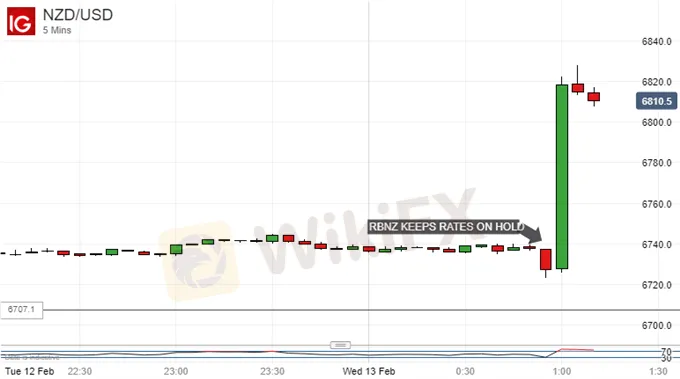简体中文
繁體中文
English
Pусский
日本語
ภาษาไทย
Tiếng Việt
Bahasa Indonesia
Español
हिन्दी
Filippiiniläinen
Français
Deutsch
Português
Türkçe
한국어
العربية
NZD Spikes Despite Quite Dovish RBNZ. Rates Remain On Hold
Abstract:The New Zealand Dollar got a lift despite the Reserve Bank of New Zealand leaving interest rates alone. The market was clearly expecting a more
First-quarter technical and fundamental forecasts from the DailyFX analysts are out now.
The New Zealand Dollar rose Wednesday after the Reserve Bank of New Zealand left its Official Cash Rate on hold at 1.75%. The rate has been unchanged since November 2016.
The RBNZ said it now doesnt see any rises in interest rates until 2021, although it said the next move could be ether up or down. It also said that unemployment in the country was probably close to its maximum sustainable level.
Given that, it is hard to see quite why NZD/USD reacted as bullishly as it did, with the possibility that markets were braced for even more dovish commentary than they got one possible explanation – and indeed the only likely one to emerge so far. AUD/USD spiked at the same time.
Cleveland Federal Reserve President Loretta Mester did cross the wires at about the same time with the view that US rates were probably close to neutral. This might have weakened the US Dollar a little although there was little evidence of this in other currency pairs.

On its daily chart NZD/USD has broken below the uptrend channel which marked 2019s trade until last week. The US Dollar took an early hit as investors adjusted to a more cautious rate-raising path from the US Federal Reserve. However, other central banks appear to have joined it, most notably perhaps the Reserve Bank of Australia which last week admitted that its own OCR could yet fall from record lows.

The RBA also downgraded its growth and inflation assumptions, and the New Zealand Dollar clearly shared it some of the pain felt by AUD/USD bulls in the aftermath.
The New Zealand Dollar clearly remains in thrall to a similar policy rethink, with the lows of January 22 at 0.6707 in bearish focus now. They in turn guard the way South to 0.6562- the low of this year so far and also the lowest point since November 1, 2018.
Disclaimer:
The views in this article only represent the author's personal views, and do not constitute investment advice on this platform. This platform does not guarantee the accuracy, completeness and timeliness of the information in the article, and will not be liable for any loss caused by the use of or reliance on the information in the article.
Read more

Week Ahead Spotlight: CPIs, Retail Sales, RBNZ Rates!
In March, Canada's consumer price index increased by 0.6% compared to the previous month, surpassing the 0.3% growth seen earlier. In April, the Reserve Bank of New Zealand opted to maintain its official cash rate at 5.5 percent for the sixth consecutive meeting, emphasizing the ongoing need to address inflation fully. In March, the UK Consumer Price Index registered a slower-than-anticipated increase, reaching 3.2% in annual terms, down from the 3.4% rise observed in February. In March, UK...

Rate Rumble: RBNZ, BoC, and ECB Take Centre Stage
The New Zealand central bank maintain its benchmark interest rate at 5.50% as expected during its previous meeting. While there was no surprise of the central bank paused rates, the less hawkish tone was a surprise as 23% of the market surveyed by Reuters predicted an interest rate hike. In February, the rate of consumer price growth in the United States picked up pace with the reading came in at 3.2%, surpassing expectations of 3.1% for underlying inflation.

NZD/USD Grapples 0.7000 With RBNZ’s Inflation Expectations Survey on Deck
New Zealand Dollar holds firm while risk-sensitive Australian Dollar falls overnight. RBNZ's inflation expectations survey in focus as the central bank’s rate decision nears. NZD/USD looks to retake the 0.7000 psychological level after bouncing from support

NZD/USD Gyrates at Support as Economic Strength Bolsters RBNZ Rate Hike Bets
APAC traders look to close the week out on a bright note following Wall Street rebound. RBNZ rate hike bets continue to strengthen as economy recovers from Covid lockdowns. And, NZD/USD clings to 100-day Simple Moving Average (SMA) after overnight drop.
WikiFX Broker
Latest News
What Makes Cross-Border Payments Easier Than Ever?
Trader Exposes Unethical Practices by STP Trading
Italian Regulator Warns Against 5 Websites
Currency Calculator


